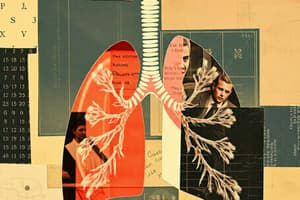Podcast
Questions and Answers
What initiates the process of inspiration?
What initiates the process of inspiration?
- Contraction of external inter-costal muscles and diaphragm (correct)
- Relaxation of thoracic muscles
- Contraction of the diaphragm and internal inter-costal muscles
- Increase in atmospheric pressure
What happens to intra-pulmonary pressure during expiration?
What happens to intra-pulmonary pressure during expiration?
- It stays the same as atmospheric pressure
- It fluctuates unpredictably
- It increases to above atmospheric pressure (correct)
- It decreases below atmospheric pressure
Which respiratory volume is defined as the amount of air a person can forcibly inspire beyond normal breathing?
Which respiratory volume is defined as the amount of air a person can forcibly inspire beyond normal breathing?
- Tidal Volume (TV)
- Residual Volume (RV)
- Expiratory Reserve Volume (ERV)
- Inspiratory Reserve Volume (IRV) (correct)
What is the approximate tidal volume for a healthy adult during normal respiration?
What is the approximate tidal volume for a healthy adult during normal respiration?
What is the significance of vital capacity in respiratory function?
What is the significance of vital capacity in respiratory function?
How many times does a healthy human generally breathe in a minute?
How many times does a healthy human generally breathe in a minute?
What role do additional abdominal muscles play during respiration?
What role do additional abdominal muscles play during respiration?
Which of the following describes the volume of air remaining in the lungs after normal breathing?
Which of the following describes the volume of air remaining in the lungs after normal breathing?
Why does gas diffusion occur primarily in the alveolar region rather than in other parts of the respiratory system?
Why does gas diffusion occur primarily in the alveolar region rather than in other parts of the respiratory system?
Which technique is used to estimate the volume of air involved in breathing movements?
Which technique is used to estimate the volume of air involved in breathing movements?
What happens to the partial pressures of oxygen (pO2) and carbon dioxide (pCO2) when comparing atmospheric air to alveolar air?
What happens to the partial pressures of oxygen (pO2) and carbon dioxide (pCO2) when comparing atmospheric air to alveolar air?
What is the average Expiratory Reserve Volume (ERV) for a healthy adult?
What is the average Expiratory Reserve Volume (ERV) for a healthy adult?
During normal inspiration, which process correctly describes how air enters the lungs?
During normal inspiration, which process correctly describes how air enters the lungs?
How does an increase in pCO2 levels affect oxygen transport in the blood?
How does an increase in pCO2 levels affect oxygen transport in the blood?
What is the primary role of residual volume (RV) in pulmonary function assessment?
What is the primary role of residual volume (RV) in pulmonary function assessment?
How is functional residual capacity (FRC) calculated?
How is functional residual capacity (FRC) calculated?
Which of the following values is considered normal for residual volume in healthy adults?
Which of the following values is considered normal for residual volume in healthy adults?
What does vital capacity (VC) encompass?
What does vital capacity (VC) encompass?
Which factors primarily drive the exchange of gases in the alveoli?
Which factors primarily drive the exchange of gases in the alveoli?
In the context of respiratory mechanics, what does inspiratory capacity (IC) refer to?
In the context of respiratory mechanics, what does inspiratory capacity (IC) refer to?
What is the total lung capacity (TLC) comprised of?
What is the total lung capacity (TLC) comprised of?
Which capacity reflects the total air volume remaining after normal expiration?
Which capacity reflects the total air volume remaining after normal expiration?
Flashcards are hidden until you start studying
Study Notes
Breathing Mechanics
- External intercostal muscles contract, lifting ribs and sternum, increasing thoracic chamber volume.
- Increased thoracic volume raises pulmonary volume, lowering intra-pulmonary pressure below atmospheric pressure, allowing air to flow into lungs (inspiration).
- Relaxation of diaphragm and intercostal muscles returns diaphragm and sternum to normal, reducing thoracic and pulmonary volumes, raising intra-pulmonary pressure above atmospheric pressure, forcing air out (expiration).
- Strength of inspiration and expiration can be enhanced using abdominal muscles.
- Average human breathing rate is 12-16 breaths per minute.
- Breathing volume can be evaluated using a spirometer for clinical pulmonary function assessment.
Respiratory Volumes and Capacities
- Tidal Volume (TV): Volume of air inhaled or exhaled during normal breathing; ~500 mL. A healthy person can move ~6000-8000 mL of air per minute.
- Inspiratory Reserve Volume (IRV): Additional air a person can inhale forcibly; averages 2500-3000 mL.
- Expiratory Reserve Volume (ERV): Extra air a person can forcibly exhale; averages 1000-1100 mL.
- Residual Volume (RV): Air remaining in the lungs post-forced expiration; averages 1100-1200 mL.
Derived Respiratory Capacities
- Inspiratory Capacity (IC): Total air that can be inhaled post-normal expiration (TV + IRV).
- Expiratory Capacity (EC): Total air that can be exhaled post-normal inspiration (TV + ERV).
- Functional Residual Capacity (FRC): Air remaining post-normal expiration (ERV + RV).
- Vital Capacity (VC): Maximum air breathed in post-forced expiration (ERV + TV + IRV) or maximum air exhaled after forced inspiration.
- Total Lung Capacity: Overall air volume in lungs post-forced inspiration (RV + ERV + TV + IRV).
Gas Exchange
- Alveoli serve as primary sites for gas exchange.
- Gases (O2 and CO2) are exchanged via simple diffusion along pressure/concentration gradients.
Studying That Suits You
Use AI to generate personalized quizzes and flashcards to suit your learning preferences.




